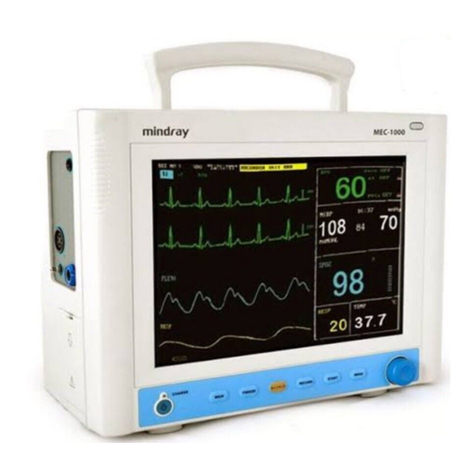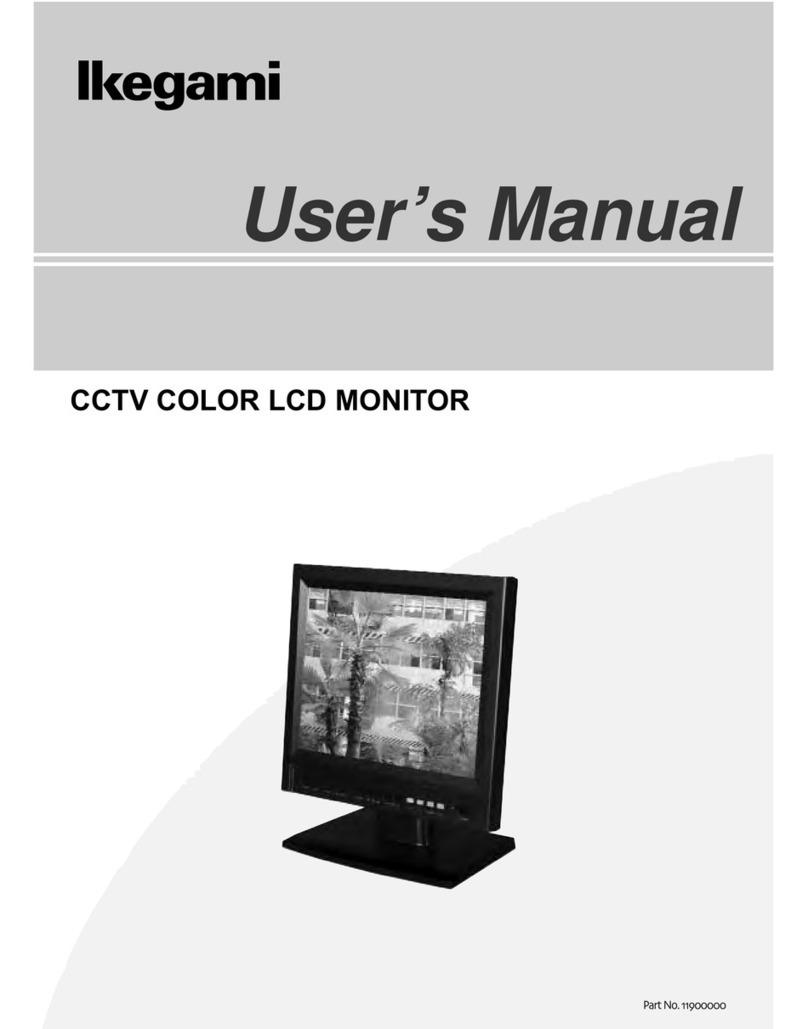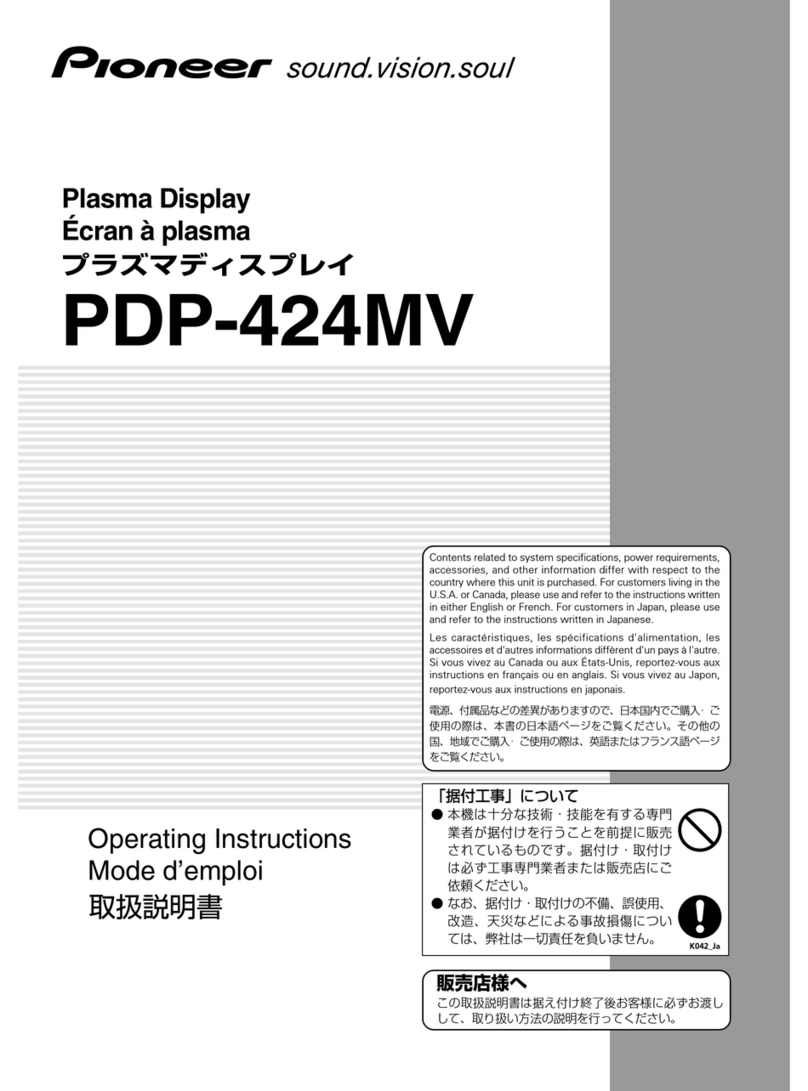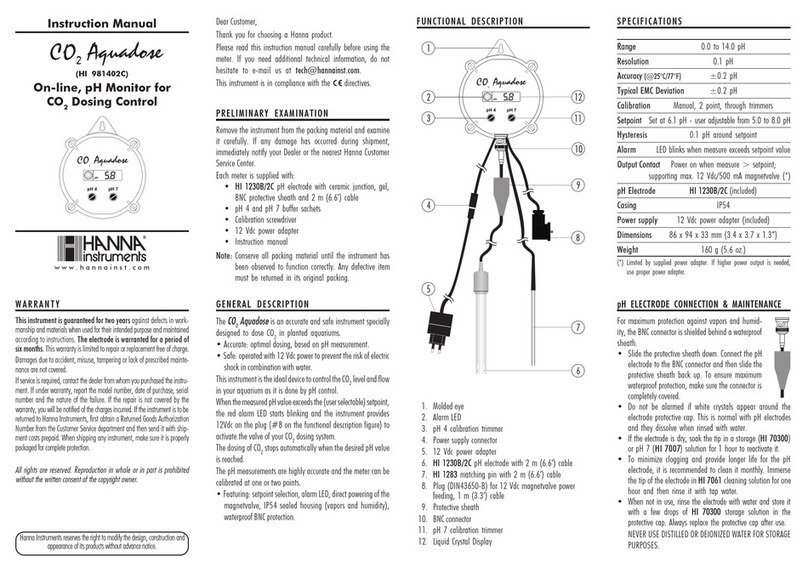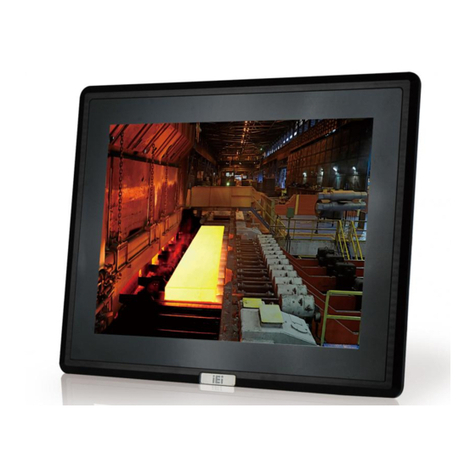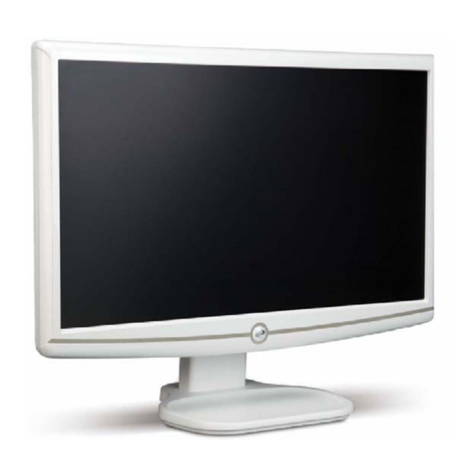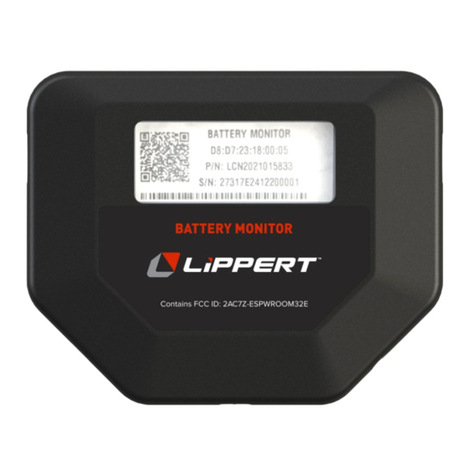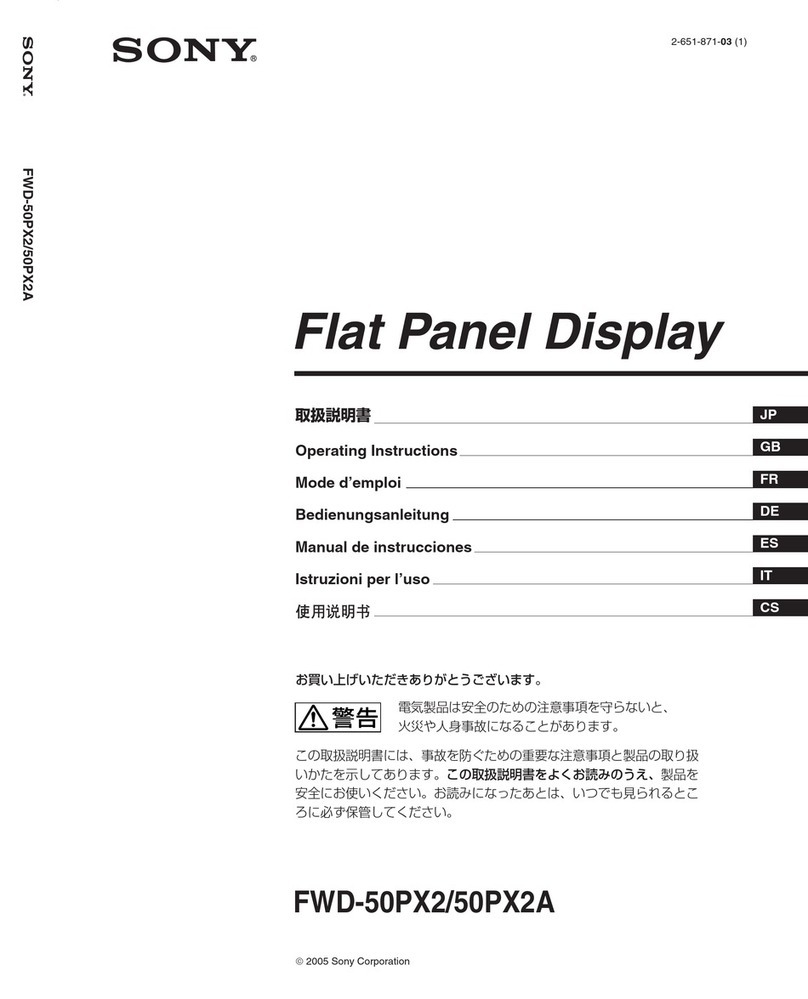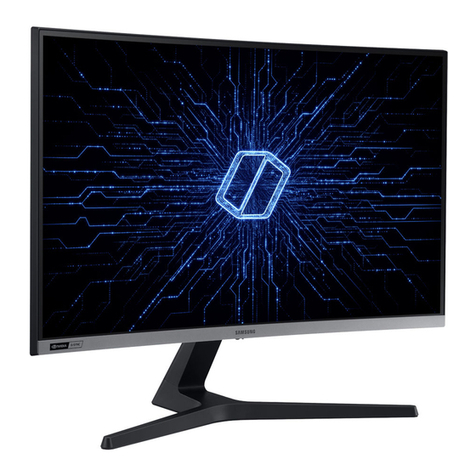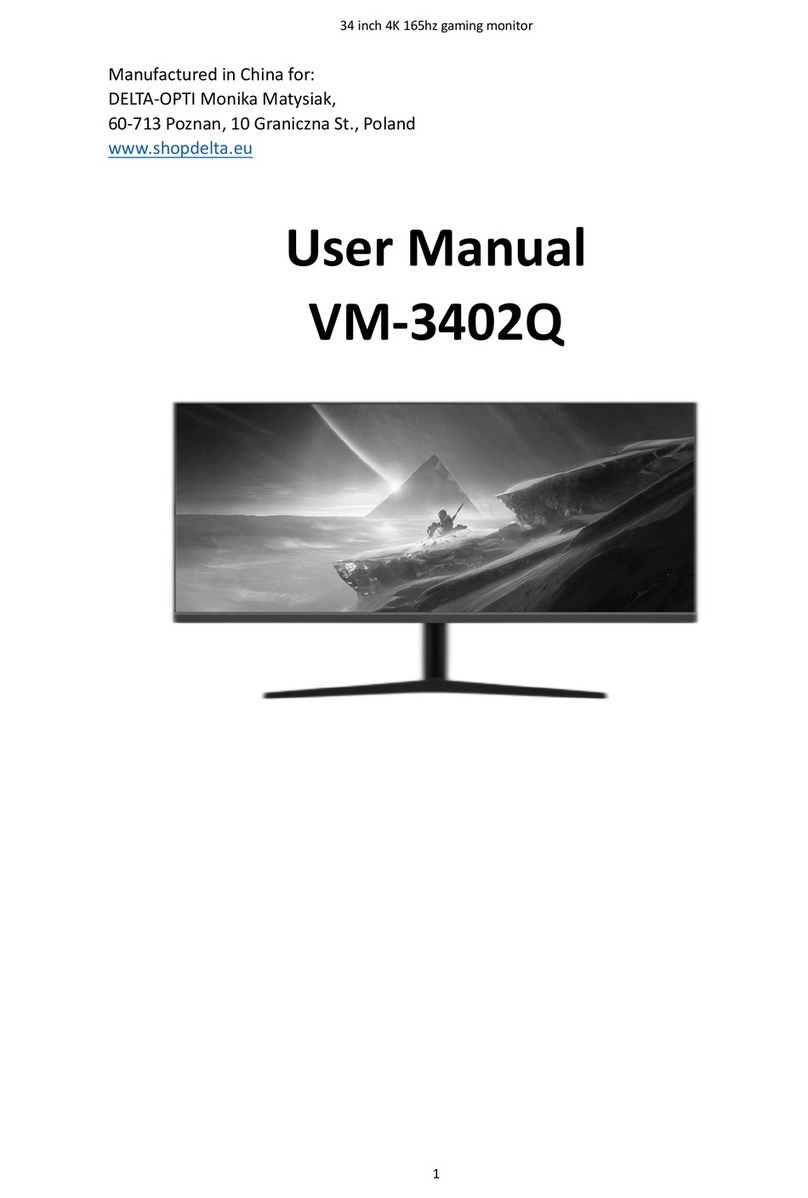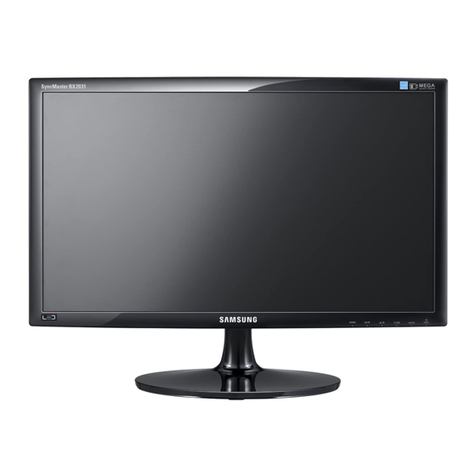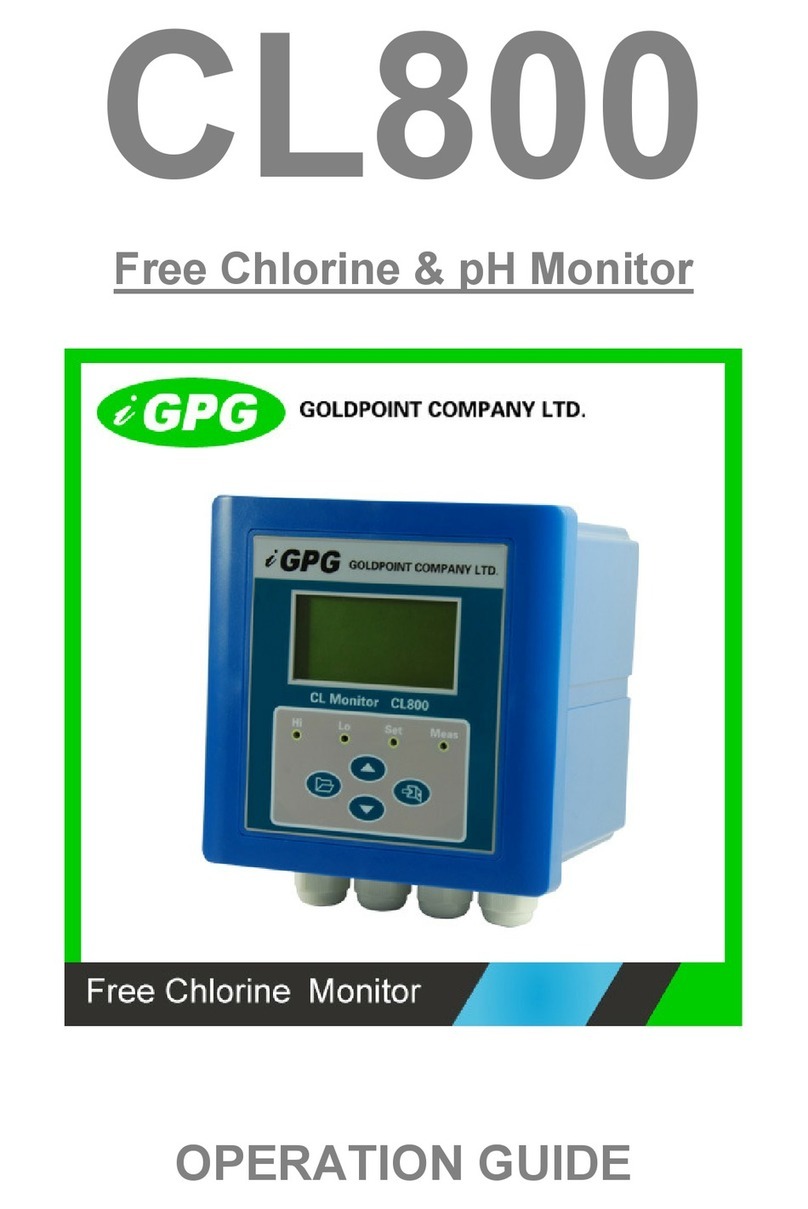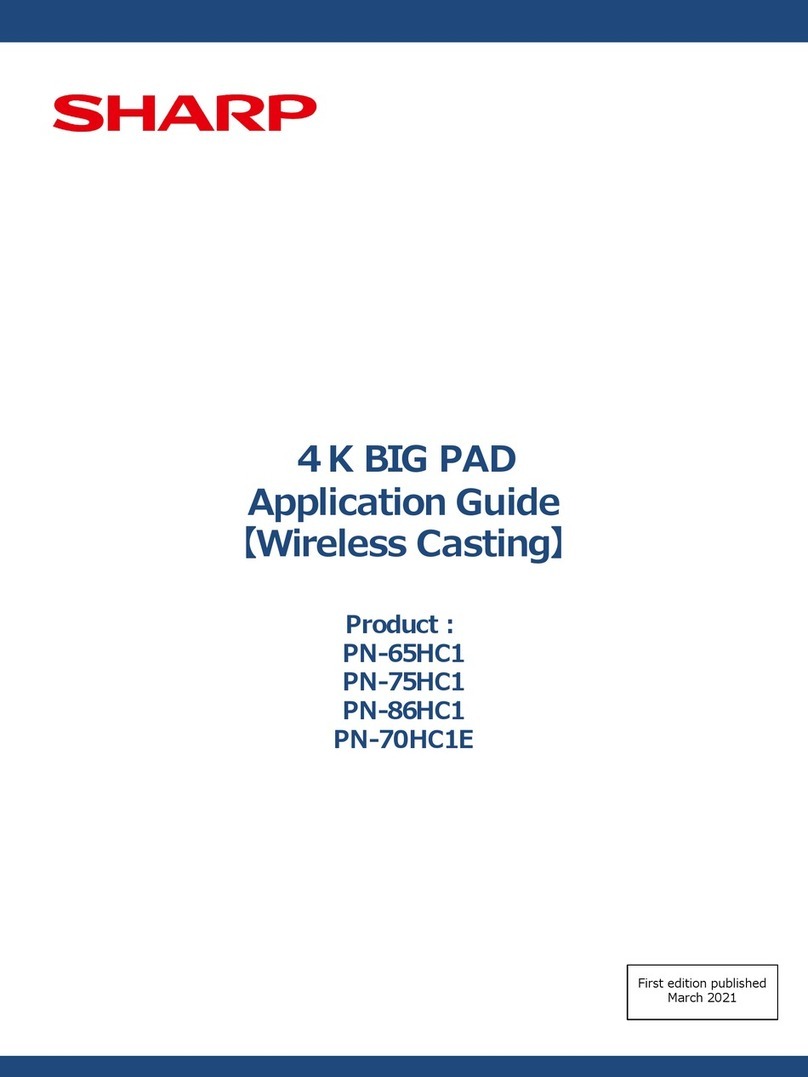Shenzhen Mindray Bio-Medical Electronics PM-8000 User manual

Service Manual
of
PM-8000
Portable Patient Monitor


Copyright
SHENZHEN MINDRAY®BIO-MEDICAL ELECTRONICS CO., LTD. 2002
Version: 2.0
Issued date: 2005/07/24
P/N: 8000-20-10282
Statement
SHENZHEN MINDRAY®BIO-MEDICAL ELECTRONICS CO., LTD. (hereinafter called Mindray)
owns all rights to this unpublished work and intends to maintain this work as confidential. Mindray
may also seek to maintain this work as an unpublished copyright. This publication is to be used solely
for the purposes of reference, operation, maintenance, or repair of Mindray equipment. No part of this
can be disseminated for other purposes.
In the event of inadvertent or deliberate publication, Mindray intends to enforce its rights to this work
under copyright laws as a published work. Those having access to this work may not copy, use, or
disclose the information in this work unless expressly authorized by Mindray to do so.
All information contained in this publication is believed to be correct. Mindray shall not be liable for
errors contained herein nor for incidental or consequential damages in connection with the furnishing,
performance, or use of this material. This publication may refer to information and protected by
copyrights or patents and does not convey any license under the patent rights of Mindray, nor the rights
of others. Mindray does not assume any liability arising out of any infringements of patents or other
rights of third parties.
Content of this manual is subject to changes without prior notice.
PROPERTY OF
SHENZHEN MINDRAY®BIO-MEDICAL ELECTRONICS CO., LTD.
ALL RIGHTS RESERVED
Responsibility on the manufacturer party
Service Manual of PM-8000 Portable Patient Monitor (V2.0) I

Mindray is responsible for safety, reliability and performance of this equipment only in the condition
that:
•all installation, expansion, change, modification and repair of this equipment are conducted by
Mindray qualified personnel; and,
•applied electrical appliance is in compliance with relevant National Standards; and,
•the monitor is operated under strict observance of this manual.
′NOTE ′
This equipment is not intended for family usage.
Warning
This monitor is not a device for treatment purpose.
It is important for the hospital or organization that employs this equipment to carry out a reasonable
maintenance schedule. Neglect of this may result in machine breakdown or injury of human health.
Upon request, Mindray may provide, with compensation, necessary circuit diagrams, calibration
illustration list and other information to help qualified technician to maintain and repair some parts,
which Mindray may define as user serviceable.
II Service Manual of PM-8000 Portable Patient Monitor (V2.0)

Warranty
Workmanship & Materials
Mindray guarantees new equipment other than accessories to be free from defects in workmanship and
materials for a period of one year (six months for multi-site probes and SpO2 sensor) from date of
shipment under normal use and service. Mindray's obligation under this warranty is limited to repairing,
at Mindray’s option, any part which upon Mindray's examination proves defective.
THIS WARRANTY IS EXCLUSIVE AND IS IN LIEU OF ALL OTHER WARRANTIES,
EXPRESSED OR IMPLIED, INCLUDING WARRANTIES OF MERCHANT ABILITY OR
FITNESS FOR ANY PARTICULAR PURPOSE.
Exemptions
Mindray's obligation or liability under this warranty does not include any transportation or other
charges or liability for direct, indirect or consequential damages or delay resulting from the improper
use or application of the product or the substitution upon it of parts or accessories not approved by
Mindray or repaired by anyone other than a Mindray authorized representative.
This warranty shall not extend to any instrument which has been subjected to misuse, negligence or
accident; any instrument from which Mindray's original serial number tag or product identification
markings have been altered or removed, or any product of any other manufacturer.
Safety, Reliability and Performance
Mindray is not responsible for the effects on safety, reliability and performance of the PM-8000
Portable Patient Monitor if:
■ assembly operations, extensions, re-adjusts, modifications or repairs are carried out by persons
other than those authorized by Mindray.
■ the PM-8000 Portable Patient Monitor is not used in accordance with the instructions for use, or
the electrical installation of the relevant room does not comply with NFPA 70: National Electric
Code or NFPA 99: Standard for Health Care Facilities (Outside the United States, the relevant
room must comply with all electrical installation regulations mandated by the local and regional
bodies of government).
Service Manual of PM-8000 Portable Patient Monitor (V2.0) III

Return Policy
Return Procedure
In the event that it becomes necessary to return a unit to Mindray, the following procedure should be
followed:
1. Obtain return authorization. Contact the Mindray Service Department and obtain a Customer
Service Authorization (Mindray) number. The Mindray number must appear on the outside of the
shipping container. Return shipments will not be accepted if the Mindray number is not clearly
visible. Please provide the model number, serial number, and a brief description of the reason for
return.
2. Freight policy. The customer is responsible for freight charges when equipment is shipped to
Mindray for service (this includes customs charges).
Company Contact
Address: Mindray building keji 12th road south hi-tech industrial
park nanshan Shenzhen, P.R.China
Phone: +86 755 26582658/26582888
Fax: +86 755 26582680
Free hot line: +86 800 830 3312
EC Representative
Name: Shanghai International Holding Corp. GmbH(Europe)
Address: Eiffestrasse 80 D-20537 Hamburg Germany
Phone: +49 40 2513174
Fax: +49 40 255726
IV Service Manual of PM-8000 Portable Patient Monitor (V2.0)

Preface
This manual gives detailed description to PM-8000 Portable Patient Monitor concerning its
performance, operation, and other safety information. Reading through this manual is the first step for
the user to get familiar with the equipment and make the best out of it.
Following symbols indicates some important facts that you have to pay special attention to:
Warning Points to be noted to avoid injury to the patient and the operator.
Caution Points to be noted to avoid damage to the equipment.
′NOTE ′Points to be noted.
This manual is intended for persons who are trained in the use of this field and have adequate
experience in operation of monitoring equipment.
Service Manual of PM-8000 Portable Patient Monitor (V2.0) V


Content
Chapter 1 Introduction ........................................................................................................................1-1
I. General.................................................................................................................................... 1-1
II. Appearance............................................................................................................................ 1-2
2.1 Screen display ................................................................................................................. 1-2
2.2 Button Functions............................................................................................................. 1-6
2.3 Interfaces................................................................................................................... 1-8
2.4 Built-in rechargeable battery...................................................................................... 1-10
III. Hardware principle................................................................................................................ 1-11
3.1 Power board ............................................................................................................ 1-12
3.2 PM-8000 main control board .................................................................................. 1-13
3.3 Structure diagram.................................................................................................... 1-14
3.4 Description .............................................................................................................. 1-14
3.5 Button schematic diagram and principle................................................................. 1-16
3.6 Maintenance part of TR60-A recorder.......................................................................... 1-17
Chapter 2 Monitor Functions and Principles ......................................................................................2-1
I. Introduction ............................................................................................................................... 2-1
II. ECG/RESP parameters............................................................................................................. 2-2
2.1 ECG................................................................................................................................. 2-2
2.2 RESP ............................................................................................................................... 2-2
2.3 NIBP ............................................................................................................................... 2-3
2.4 SpO2 ............................................................................................................................... 2-3
2.5 TEMP.............................................................................................................................. 2-4
2.6 IBP .................................................................................................................................. 2-4
Chapter 3 Checks and Tests................................................................................................................3-1
I. System checks......................................................................................................................... 3-1
II. Testing and calibrating each parameter.................................................................................... 3-9
Chapter 4 Troubleshooting .................................................................................................................4-1
I. Disassembly graph of each part of PM-8000............................................................................. 4-1
II. Troubleshooting guidance ........................................................................................................ 4-2
Chapter 5 Installation..........................................................................................................................5-1
I. Unpack inspection................................................................................................................. 5-1
II. Preparations before power-on................................................................................................ 5-1
III. Turn on the power................................................................................................................... 5-1
IV. Other precautions.................................................................................................................... 5-1
Chapter 6 Basic Operations ................................................................................................................6-1
Service Manual of PM-8000 Portable Patient Monitor (V2.0) 1

I. Basic operation guidance........................................................................................................... 6-1
II. Use PM-8000............................................................................................................................ 6-1
Chapter 7 Cleaning and Disinfection..................................................................................................7-1
I. Maintenance checks................................................................................................................ 7-1
II. General cleaning....................................................................................................................... 7-1
III. Sterilization ............................................................................................................................. 7-2
IV. Precautions and cleaning ........................................................................................................ 7-3
V. IBP transducer cleaning and disinfection(reusable)........................................................... 7-4
VI. TEMP sensor cleaning and disinfection (reusable) ............................................................. 7-6
Chapter 8 Maintenance .......................................................................................................................8-1
Chapter 9 Network Link .....................................................................................................................9-1
I. Network performance ............................................................................................................. 9-1
II. Application ............................................................................................................................... 9-1
Appendix I: System Alarm Prompt................................................................................................... AI-i
Appendix II: Product Specifications................................................................................................ AII-i
1. Classification...........................................................................................................................AII-i
2. Specifications..........................................................................................................................AII-i
2 Service Manual of PM-8000 Portable Patient Monitor (V2.0)

Introduction
Chapter 1 Introduction
I. General
Environment:
Temperature
Working 0 ~ 40 °C
Transport and Storage -20 ~ 60 °C
Humidity
Working 15% ~ 95%
Transport and Storage 10% ~ 95%
Altitude
Working -500 to 4,600m
Transport and Storage -500 to 13,100m
Power Supply
100~240 (V)AC, 50/60 Hz
Pmax=100VA
FUSET1.6A
PM-8000 Portable Patient Monitor (Figure 1-1) is adaptable to adult, pediatric and neonatal
usage. It can monitor vital signals such as ECG, Respiratory Rate, SpO2, NIBP, TEMP and IBP. It
integrates parameter measuring modules, display and recorder into one device, featuring in
compactness, lightweight and portability. Replaceable built-in battery facilitates the transportation of
patient. Large high-resolution display provides clear view of 5 waveforms and full monitoring
parameters.
PM-8000 Portable Patient Monitor performs monitoring of:
Heart Rate (HR)
2-channel ECG waveforms
ECG
Arrhythmia and S-T segment analysis(optional)
Respiratory Rate (RR)
RESP
Respiration Waveform
Oxygen Saturation (SpO2), Pulse Rate (PR)
SpO2
SpO2 Plethysmogram
NIBP Systolic Pressure (NS), Diastolic Pressure (ND), Mean Pressure (NM)
Service Manual of PM-8000 Portable Patient Monitor (V2.0) 1-1

Introduction
TEMP Temperature DATA
IBP IBP SYS, DIA, MAP
IBP waveform
PM-8000 provides extensive functions as visual & audible alarm, storage and report printout for
trend data, NIBP measurements, and alarm events, and drug dose calculation, etc.
II. Appearance
The POWER switch is on the right quarter of the front panel (②). The POWER indicator(④)
and the BATT indicator (③) light when the device is powered on. The ALARM indicator flashes or
lights when alarm occurs (①). Sockets for the sensors are on the right side. The recorder socket is on
the left side. Other sockets and power plug-in are at the back.。
Figure 1-1 Front view of PM-8000 Portable Patient Monitor
2.1 Screen display
The display of PM-8000 may be color or monochrome liquid crystal. (The monitor of PM-8000 is
available in both monochrome and color liquid crystal).Patient parameters, waveforms, alarm messages,
bed numbers, date, system status and error messages can be displayed on the screen.
The screen is divided into three areas: ←message area①; ↑waveform area②; →parameter area
1-2 Service Manual of PM-8000 Portable Patient Monitor (V2.0)

Introduction
Figure 1-2 PM-8000 main screen
Message Area(①)
The Message Area is at the top of the screen and used to display operating state of the monitor and
status of the patient.
The messages and their meanings are:
【BED No】Bed number of the patient being monitored
【3/1/2001】Currentdate
【10:23:45】Currenttime
【M/F】Sex of the patient being monitored
【NAME】name of the patient being monitored. When the user is entering patient name,
the name will be displayed at this position. If no patient name is entered, this
position will be blank.
Other information in the Message Area comes up only with respective monitoring status. They are:
1. Signs indicating the operating status of the monitor and the sensors are displayed at the right side of
time numeric. When appears, this message will cover the sex and name information of the patient.
2. “ ” Indicates that all sounds are disabled manually. It appears when SILENCE button is pressed
for more than 1 seconds.
3. “!” is the sign indicating that the alarm volume is closed. When select the “OFF” option in the
ALARM SETUP menu, this mark appears indicating that the operator has permanently closed the
Service Manual of PM-8000 Portable Patient Monitor (V2.0) 1-3

Introduction
audio alarm function. This audio alarm function can resume only after the operator discharges the setup
of Close Alarm Volume.
′NOTE ′
When “!
” sign appears, the system can not give any audio alarm prompt. Therefore,
the operator should be careful in using this function. One method of discharging this
status is in the ALARM SETUP menu, select the item that the alarm volume is in
Non-close. Another method is to press the SILENCE button so as to make the mark
change into a
. Then press SILENCE button again, the system will immediately
restores the normal alarm status.
4. Alarm message is displayed always at the extreme right area on the screen.
5. When waveforms on the screen are frozen, “FREEZE” window appears at the bottom of the screen.
Waveform/Menu Area(②)
Five waveforms can be displayed at the same time. The waveforms from up to down are: 2 channels of
ECG waveforms, SpO2 Plethysmogram, IBP, RESP (possibly coming from ECG module). Waveforms
to be displayed are user-selectable. Refer to Tracing Waveforms Selection in Operation Manual for
details.
The names of the waveforms are displayed to their left. The names of ECG and IBP are user-selectable.
Refer to Chapter ECG/RESP Monitoring and Chapter IBP Monitoring in Operation Manual for
details. Gain and filter of this ECG channel are displayed as well. A 1mv scale is marked on the right
of ECG waveform. The IBP waveform scale is displayed in IBP wave area. The three dot lines from up
to down respectively represent the highest scale, reference scale and lowest scale of the waveform.
These values can be manually set. Refer to Chapter IBP Monitoring in Operation Manual for IBP
setup.
The same menu always appears at a fixed area on the screen. When the menu is displayed, some
waveforms become invisible. The size of the menu is also fixed, covering the lowest 3, 4 or 5
waveforms. If the system exits the menu, the screen will restore its previous look.
The waveforms are refreshed in a user-set rate. Refer to the related chapters for details of sweep speed.
Parameter Area(③)
Parameters are displayed at a fixed position (①~⑩). They are (from top to bottom):
1-4 Service Manual of PM-8000 Portable Patient Monitor (V2.0)

Introduction
Figure 1-3 Main Screen
ECG
Heart Rate (①, Unit: bpm)⎯
⎯
⎯
⎯
⎯
⎯
⎯
⎯
ST-segment analysis of Channel 1 & 2 (②, Unit: mv)
Arrhythmia (PVCs) events (③, Unit: event/min)
NIBP
(From left to right) Systolic, Mean, Diastolic (④, Unit: mmHg or kPa)
SpO2
SpO2 (⑤, Unit: %)
IBP
Blood Pressure: Systolic, Mean, and Diastolic values are displayed from left to right. (⑥,
Unit: mmHg or kPa)
RESP
Respiration Rate (⑦, Unit: breath/min)
TEMP
Temperature (⑧, Unit:℃or ℉)
Service Manual of PM-8000 Portable Patient Monitor (V2.0) 1-5

Introduction
The above monitoring results are displayed in the Parameter Area.
The parameters refresh every second, except that the NIBP value refreshes each time when the
measurement is over.
User can select the monitor parameters, and the screen display will change accordingly.
Alarm indicator and alarm status:
In normal mode, no indicator lights.
In alarm mode, the alarm indicator lights or flashes. The color of the indicator indicates the alarm level.
2.2 Button Functions
Figure 1-4 PM-8000 Buttons and Knob
All the operations of PM-8000 can be performed through using the buttons and the rotary knob at the
bottom of the screen. Above the buttons are their respective names. They are (from left to right):
①POWER Press to turn on/off the monitor.
②FREEZE When in normal mode, press to enter Freeze mode to freeze all the waveforms
on the screen. When in Freeze mode, press to restore the waveform
refreshing.
1-6 Service Manual of PM-8000 Portable Patient Monitor (V2.0)

Introduction
③SILENCE Press to suspend alarm for 3 minutes (it can be selected in ALARM SETUP
menu). Press this button for more than 1 seconds to disable all sound signals
(heart, beat, pulse tone, key sound), and audio alarm. A symbol “ ” displays
in the Message Area. Press this key again to restore all sound signals and
remove the “ ” symbol.
NOTE:
If new alarm occurs under Alarm Suspension/Silence state,
Suspension/Silence state will change. For specific rules, see Chapter
Alarm.
NOTE:
Whether an alarm will be reset depends on the status of the alarm cause.
But by pressing SILENCE button can permanently shut off audio sound
of the ECG Lead Off and SpO2 Sensor Off alarm.
④REC/STOP Press to start a real time recording. The recording time is set in RT
REC TIME of RECORD submenu (Refer to related sections for
details). Press during recording to stop the recording. When in
FREEZE mode, press to select the waveforms for report printout.
Refer to Chapter Recording for details.
⑤START Press to inflate the cuff to start a blood pressure measurement. When
measuring, press to cancel the measurement and deflate the cuff.
⑥Rotary Knob This knob can be used to select and change the settings. Operation
can be performed by turning it clockwise, counterclockwise or
pressing it down.
Rotary Knob
The square frame that moves when the knob is being turned is called "cursor". Operation can be
executed at any place where the cursor can stay. When no menu is displayed, turning the knob
clockwise can select following hot keys:
Service Manual of PM-8000 Portable Patient Monitor (V2.0) 1-7

Introduction
Channel 1 ECG lead
Channel 1 ECG gain
ECG filter
Channel 2 ECG lead
Channel 2 ECG gain
IBP Label
ECG menu
SpO2 menu
NIBP menu
IBP menu
RESP menu
TEMP menu
When the current cursor is placed at any of the first six items, the user can change the current settings.
When at any of the last six items, related parameter menu could be called up for setting changes.
2.3 Interfaces
For the convenience of operation, different interfaces are in different parts of the monitor.
Recorder is on the left side of the monitor while sockets for patient cables and sensors are on the right
side. See the figure below:
Figure 1-5 Right side view
1-8 Service Manual of PM-8000 Portable Patient Monitor (V2.0)

Introduction
This symbol means “BE CAREFUL". Refer to the manual.
Indicates that the instrument is IEC-60601-1 Type CF equipment. The unit displaying this
symbol contains an F-Type isolated (floating) patient applied part providing a high degree of
protection against shock, and is suitable for use during defibrillation.
Figure 1-6 Rear panel
Monitor interface for external:standard VGA color monitor.
Working mode: 640 ×480, 16 color, APA mode.
Signal: analog R G B 0.7 Vpp / 750 ohm
Hor. / Vert. TTL pos. / Neg.
Interface D-sub 15 pin
Pin 1. Red Video
Pin 2. Green Video
Pin 3. Blue Video
Pin 4. Ground
Pin 5. NC
Pin 6. Red Ground
Pin 7. Green Ground
Pin 8. Blue Ground
Pin 9. NC
Pin 10. Ground
Pin 11. NC
Service Manual of PM-8000 Portable Patient Monitor (V2.0) 1-9

Introduction
Pin 12. NC
Pin 13 Horizontal Sync.
Pin 14. Vertical Sync.
Pin 15. NC
Appliance: (Installation)
1) Install the VGA monitor at a place at least 1.5m away from the patient.(The VGA monitor
must be installed at least 1.5m away from the patient.)This monitor is used only as an
assistant monitoring device.
2) Plug the cable into proper socket before powering on the VGA monitor.
3) It is allowable to power on the VGA monitor and PM-8000 at the same time. Or power on
PM-8000 after turning on VGA monitor.
4) Adjust brightness and contrast properly.
(Socket ④)
Equipotential grounding terminal for connection with the hospital’s grounding system.
ANALOG OUTPUT (Socket ②)
Analog signal output terminal for connection with oscillometer and pen recorder.
The connection terminal is a BNC Jack.
Network Interfaces (Socket ①): Standard RJ45 Socket.
Warning
Through network interface only MINDRAY Clinical Information Center can be connected in.
Warning
Accessory equipment connected to the analog and digital interfaces must be certified according
to the respective IEC standards (e.g. IEC 60950 for data processing equipment and IEC 60601-1
for medical equipment). Furthermore all configurations shall comply with the valid version of
the system standard IEC 60601-1-1. Everybody who connects additional equipment to the signal
input part or signal output part configures a medical system, and is therefore responsible that the
system complies with the requirements of the valid version of the system standard IEC 60601-1-1.
If in doubt, consult the technical service department or your local representative.
2.4 Built-in rechargeable battery
PM-8000 Portable Patient Monitor is equipped with a rechargeable battery. The battery in the Monitor
can automatically recharge when AC INPUT is connected until it is full. A symbol “ ” is displayed
1-10 Service Manual of PM-8000 Portable Patient Monitor (V2.0)
Table of contents
Other Shenzhen Mindray Bio-Medical Electronics Monitor manuals
